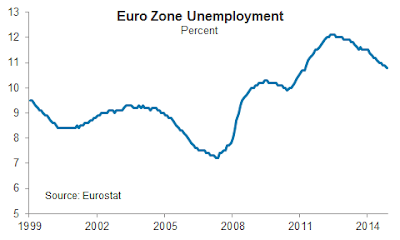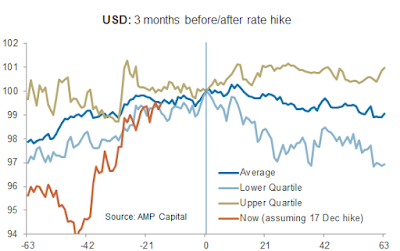[Economic Insights] Fed and ECB on divergent paths
0 views
Skip to first unread message
Bevan Graham
Nov 30, 2015, 3:50:46 PM11/30/15
to worldview...@googlegroups.com
Interest rate markets are now pricing in a
74% probability the US Federal Reserve starts the interest rate normalisation
process at its 15/16th December meeting. But before then the
European Central Bank is widely expected to step up its easing efforts in the
face of low growth and weak inflation expectations when it meets later this
week.
In comments reminiscent of his
game-changing 2012 do “whatever it takes” to save the Euro, ECB President Mario Draghi has committed the central bank
to do “what we must” to achieve its inflation target in the face of low
inflation expectations and growth that remains too low to put any significant
upward pressure on inflation.
Further action therefore appears
more than likely when the Governing Council meets on December 3rd. That could include one, some or all of:
cutting the already negative deposit rate, increasing the quantum of the
current asset purchase program or extending the duration of the program beyond
its scheduled finish of September next year.
The Euro is currently trading at
its lowest level in eight-months, indicative of market expectations of
meaningful action from the ECB this week.
The risk then is the Council reads too much into recent better data and
under-delivers. Our read of the data is
that it appears consistent with trend GDP growth, which we put at around 1.5%
per annum. The problem is the Euro zone
needs a decent burst of above trend growth to absorb the still significant
spare capacity across the region, the most obvious example of which is the
still-high unemployment rate of 10.8%.
Monetary policy can’t do that by itself.
After
delaying the start of the interest rate normalisation process in September,
markets are now pricing in a 74% chance of the Fed lifting interest rates off
zero at their December meeting. Only an
atrociously bad payrolls report this weekend appears likely to derail the Fed
from what will be their first interest rate hike in 9-years.
Markets
seem more comfortable with the prospects of higher interest rates now than they
were prior to the September meeting.
This is likely a combination of factors including the growing
understanding that interest rate increase are likely to be only gradual and
fears of a hard landing in China (and global growth) have receded. So the fact the Fed didn’t hike in September for
all the reasons they stated to some extent turns a December hike into a good
news story!
As
we have consistently argued it’s the pace of interest rate increase and the peak
(terminal rate) in rates that are more critical for markets than the timing of
the start of the process. Assuming the
Fed start to raise rates in December, we expect the Fed funds rate to be around
1.00-1.25% by December 2016. Furthermore
we expect the Fed will continue to lower its estimate of the neutral rate from the
current 3.75% towards our estimate of 3.0%.
The path of the USD will be a critical part of the outlook for interest rates. History shows us that the exchange rate does most of its work in anticipation of higher interest rates – the classic case of “buy the rumour, sell the fact”. That said the fact that the Fed and the ECB (along with the BoJ and the PBoC, amongst others) are on divergent monetary policy paths will limit the extent to which the Fed can tighten.
--
Posted By Bevan Graham to Economic Insights at 12/01/2015 09:50:00 AM
Reply all
Reply to author
Forward
0 new messages


